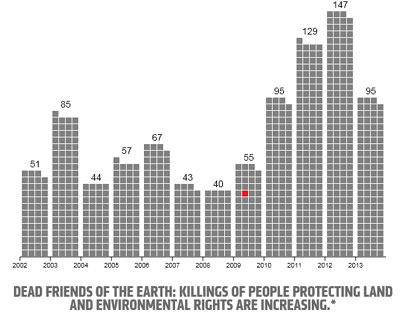As world leaders negotiate a climate treaty in Peru this week, there’s an associated crisis that doesn’t make it into the news.
Peru is the fourth most dangerous country for environmental activists, where at least 57 people have been murdered in the past 12 years.
The most recent murder occurred September 1, when four indigenous activists were shot for trying to defend their forests … and thrown into a river.
"The murders of Edwin Chota and his colleagues are tragic reminders of a paradox at work in the climate negotiations," says Patrick Alley, co-Founder of Global Witness. "While Peru’s government chairs negotiations on how to solve our climate crisis, it is failing to protect the people on the frontline of environmental protection. Environmental defenders embody the resolve we need to halt global warming. The message is clear, if you want to save the environment, then stop people killing environmental defenders."
While Peru is taking some important steps on solar and passed climate legislation in 2012, illegal logging in the Amazon continues mostly unabated. Illegal loggers were charged with the murder of the 4 activists.
Two Activists Murdered Each Week
But the story is much bigger than that. Over the past decade, 908 activists have been murdered in 38 countries, according to Global Witness, calling it a very conservative estimate. And police and the military are behind most of them. Over the last four years, the death rate has risen to an average of two activists a week.

Indeed, as environmental activists ramp their protests in a desperate call for action on climate change and protection of the natural world, governments in many countries are cracking down instead of protecting them. Only 10 murderers have been convicted.
Disputes over industrial logging, mining and land rights are the key drivers, and Latin America and Asia-Pacific are particularly hard hit, says Global Witness in the report, Deadly Environment: The Dramatic Rise In Killings of Environmental and Land Defenders. Brazil is #1 with 448 murders, followed by Honduras (109) and the Philippines (67).
"It has never been more important to protect the environment, and it has never been more deadly," says Oliver Courtney of Global Witness. "There can be few starker or more obvious symptoms of the global environmental crisis than a dramatic upturn in killings of ordinary people defending rights to their land or environment. Yet this rapidly worsening problem is going largely unnoticed, and those responsible almost always get away with it. We hope our findings will act as the wake-up call that national governments and the international community clearly need."
Land rights are behind most murders, as companies and governments increasingly collude on secret deals that give away land to grow crops like palm oil, or for mining or industrial logging – often forcing people off their traditional lands.
That’s the case in Peru, where only 38% of indigenous groups hold legal rights to their traditional lands. Others stand by helplessly as their land is logged and mined, facilitated by a new law (30230) that gives unprecedented land use rights to developers.
And this is after Peru signed a deal with Norway to become carbon neutral by 2021, which hinges on dramatically reducing deforestation – at the highest rates in 12 years. Norway will give Peru $300 million for verified results – by recognizing indigenous peoples’ land claims.
Indigenous groups are owed title to 20 million hectares of land, which should be processed immediately, says Global Witness, and the government should investigate connections between illegal loggers, miners and public officials, while cracking down on these illegal activities. Repeal law 30230 and another law that allows security forces to use force against peaceful protestors, they say.
Peru is still blessed with forests that cover 60% of the country and it has 350,000 indigenous people, many of which have been fighting for their forests for decades.
But "nearly a billion metric tons of carbon stocks are at imminent risk for emission into the atmosphere due to land uses such as fossil fuel oil exploration, cattle ranching, oil palm plantations and gold mining," says Greg Asner of the Carnegie Institution for Science, in research published in Proceedings of the National Academy of Sciences. The good news is that if the 20 million hectares were returned to indigenous tribes, that would be a good start in counteracting the land loss.
And it’s not only indigenous people that are under siege. World Wildlife Fund staff received death threats when they spoke out against oil exploration in Virunga National Park in the Democratic Republic of Congo. The park’s chief warden was ambushed and killed.
One Goldman Prize winner this year limped to the podium after being shot for blocking a coal mine in India. "There is no support from the government for activists and no particular law to protect activists," he says. Another winner took Peru to local and international courts and won – the country abandoned plans for 7.2 gigawatts of hydro dams.
Meanwhile, governments – including Australia and Canada – are cracking down on environmental activists by means such as: making protests more difficult; revoking non-profit status of NGOs or passing restrictive legislation, and giving people harsh sentences when they are arrested. Even in the US, "Security agencies are increasingly spying on political activists, especially environmental groups, on behalf of corporate interests."
Read the reports by Global Witness: Peru’s Deadly Environment, and the more general piece that covers the situation worldwide: Deadly Environment – The Dramatic Rise In Killings of Environmental and Land Defenders.

